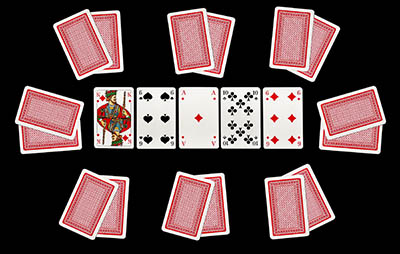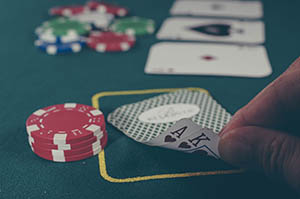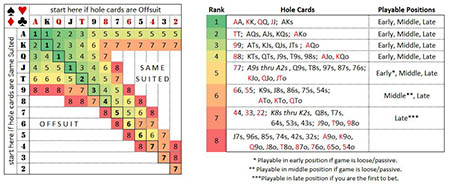
|
| « Articles | History of Playing Cards | Gallery of Playing Cards | Card Games Rules | CONTACT |
Hole Cards in Texas Hold'em
For the uninitiated, Texas Hold ‘em is the version of poker where each player is dealt two cards face down, known as the hole cards or pocket cards, and has to make a hand with five ‘community’ cards, which are dealt face up, and which every player can use.

Betting takes place after the hole cards are dealt, then again after the first three community cards are dealt together (the flop), after the forth card is dealt (the turn) and finally after the fifth community card (the river).
The skill of Texas Hold ‘em is knowing the strength of your hole cards and the likelihood of having a winning hand before the community cards are dealt. This will tell you whether to raise the bet, match the bet or save your money for better cards by folding.

The Possibilities
A standard deck of 52 cards produces 1326 possible pairings of two cards, but since there is no ranking for suits, this can be reduced to 169 non-equivalent pairs of cards.
Of these, there is a 1 in 17 chance of having a matching pair and a 4 in 17 chance of matching suits, leaving a 12 in 17 chance of having two cards that neither match in rank or suit. It is estimated that at a ten-player table, there are just 25 out of the 169 hands that have a greater than 1 in 7 probability of winning.

Ranking your Hand
The key to success lies in understanding the value or potential of your hole cards at the start of the game. There are various formulas for doing this.
Perhaps the easiest strategy to learn is the system proposed by 14 time World Series of Poker Champion, Phil Hellmuth. He groups hole cards into six tiers according to their strength as follows:
- AA, KK, AKs, QQ, AK
- JJ, TT, 99
- 88, 77, AQs, AQ
- 66, 55, 44, 33, 22, AJs, ATs, A9s, A8s
- A7s, A6s, A5s, A4s, A3s, A2s, KQs, KQ
- QJs, JTs, T9s, 98s, 87s, 76s, 65s
Clearly there will be slightly differing values within each tier, but essentially the hands within each tier can be played with the same level of confidence.
David Sklansky takes this concept further, creating eight groups as shown in the tables below. Any pair of hole cards that is not ranked under either system should be folded.

applied his PhD in mathematics to the game to create what is known as the Chen Formula, which assigns points to your hole cards as follows:
- Your highest card is given points, with A=10, K=8, Q=7, J=6 and number cards given half their face value.
- If you have a pair, these points are doubled
- If the cards match in suit, you add 2 points
- Subtract 1point for a single card gap, 2points for a two step gap, 4points for a three step gap and 5points for larger gaps
- Add 1point if the cards are adjacent or one step gap and the highest is lower than a queen.
The formula thus ranks your hand out of 20, with AA being 20 and for example 7 / 2 of different suits being worth just half a point (3˝+1-5+1)
The Chen Formula is quite complex at first, but you will pick it up quickly and it does give an accurate reflection of the strength of your hand.
Remembering your Hand
It is important to remember your hand, so you don’t look like an amateur by constantly checking, and don’t give away your chances of having a flush when suited cards are dealt in the community cards. It sounds easy enough, but under pressure in a big game, it can be easy to doubt yourself.
Clearly pairs and suited cards are easy to remember, but if you are struggling with mixed suits, try using the system developed by the late Barry Tanenbaum, which assigns a name to each combination as follows:
- diamonds and hearts — red
- clubs and spades — black
- hearts and spades — high (last in alphabetical order)
- clubs and diamonds — low (first in alphabetical order)
- diamonds and spades — pointed (tops of the pips)
- clubs and hearts — round (tops of the pips)
Hand Nicknames
Inevitably various key Texas Hold ‘em hand nicknames have gained notoriety over the years, such as rockets for a pair of aces, or fish hooks for a pair of jacks. The ‘Big Slick’ is a combination of same suit ace and king, while the amusingly titled Anna Kournikova, is an ace and king of different suits – so named because like the tennis player, it looks great but rarely wins!